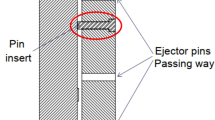Abstract
Weld line problem which occurs in polymer parts produced by plastic injection method and affects appearance and strength on a large scale was researched in this paper. The three parameters affecting operation were called injection pressure, injection time, and packing pressure which influence the quality of weld line on the polymer products were researched. A joint which enables two different parts used in different places to be joined together and its subjection to a certain loan were discussed. Considering the usage area of the part, composite of glass fiber reinforced polyamide (PA 6 GFR 30) was chosen as the material, and the design process of the part was implemented. Samples were prepared by altering the determined injection parameters. Weld line of the produced samples were subjected to tensile strength test. Their structure parts were examined under the SEM, and the results were gathered.
Similar content being viewed by others
References
Ananthanarayanan A, Gupta SK, Bruck HA (2008) Mechanical characterization of cold weld-lines and meld lines in mesoscopic revolute joints for bio inspired structures. Proceedings of the XIth International Congress and Exposition Orlando, Florida USA June:2–5
Chang TC, Fasion E (1999) Optimization of weld line quality in injection molding using an experimental design approach. Journal of Injection Molding Technology 3:61–66
Chen CS, Chen TJ, Chien RD, Chen SC (2007) Investigation on the weldline strength of thin-wall injection molded ABS parts. International Communications in Heat and Mass Transfer 34:448–455. doi:10.1016/j.icheatmasstransfer.2007.01.005
Chen SC, Jong WR, Chang JA (2006) Dynamic mold surface temperature control using induction heating and its effects on the surface appearance of weld line. Journal of Applied Polymer Science 101:1174–1180. doi:10.1002/app.24070
Chun DH (1999) Cavity filling analyses of injection molding simulation: bubble and weld line formation. Journal of Materials Processing Technology 89:177–181. doi:10.1016/S0924-0136(99)00052-7
Fellahi S, Fisa B, Favis BD (1995) Weldline strength in injection molded HDPE/PA6 blends: influence of interfacial modification. Journal of Applied Polymer Science 57:1319–1332. doi:10.1002/app.1995.070571109
Gava A, Tosello G, Lucchetta G, Hansen HN, Marinello F (2009) Characterization and analysis of weld lines on micro-injection moulded parts using atomic force microscopy (AFM). Wear 266:534–538. doi:10.1016/j.wear.2008.04.077
Guilong W, Guoqun Z, Xiaoxin W (2013) Effects of cavity surface temperature on mechanical properties of specimens with and without a weld line in rapid heat cycle molding. Materials and Design 46:457–472. doi:10.1016/j.matdes.2012.10.054
Hashemi S (2010) Effect of temperature on weldline integrity of injection moulded short glass fibre and glass bead filled ABS hybrids. Polymer Testing 29:327–336. doi:10.1016/j.polymertesting.2009.12.007
Kagitci YC (2006) A research of weld line problem related to flow on a polymer composite part designed with CAD and reinforced of glass fiber. This study is a part of Master Thesis, Selcuk University, Konya
Kharbas H, Turng LS, Spindler R (2002) Study of weld-line strength and microstructure of injection molded microcellular parts. Department of Mechanical Engineering University of Wisconsin, Madison
Kovács JG, Sikló B (2010) Experimental validation of simulated weld line formation in injection moulded parts. Polymer Testing 29:910–914. doi:10.1016/j.polymertesting.2010.06.003
Ogadhoh SO, Papathanasiou TD (1997) On microstructure at the weld line in injection molded particulate composites. Scripta Material 37:1143–1149. doi:10.1016/S1359-6462(97)00236-4
Rosata D, Rosata D (1995) Injection molding handbook, vol 1145. Charman & Hall, New York
Author information
Authors and Affiliations
Corresponding author
Rights and permissions
About this article
Cite this article
Kagitci, Y.C., Tarakcioglu, N. The effect of weld line on tensile strength in a polymer composite part. Int J Adv Manuf Technol 85, 1125–1135 (2016). https://doi.org/10.1007/s00170-015-8007-0
Received:
Accepted:
Published:
Issue Date:
DOI: https://doi.org/10.1007/s00170-015-8007-0




